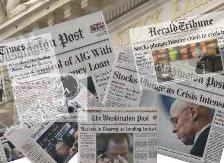Alan Greenspan, the former five-term Fed chief once described as "the greatest central banker in history," has lately given us a new number to think about. Testifying last week before the Financial Crisis Inquiry Commission in Washington, D.C., Greenspan was asked by Commission Chair Phil Angelides if he had erred in failing to impose regulatory measures that could have prevented or mitigated the financial meltdown. Instead of answering, Greenspan replied that, over the course of his 21 years in government, "I was right 70 percent of the time but I was wrong 30 percent of the time."
Seventy percent right, 30 percent wrong: in the ever-combustible ecosystem of the blogosphere, Greenspan's personal-fallibility pie chart ignited a firestorm of vitriol and scorn. The question is: why? In a culture where admissions of error by public officials are as rare as Yangtze river dolphins, one might imagine that Greenspan's comparative candor would earn some plaudits.
I've spent most of the last five years studying how we respond to mistakes - our own as well as other people's - and I'd argue that there are three reasons Greenspan's admission made us more rather than less angry with him. The first has to do with context. Consider, for a moment, the remarkably chameleon significance of the 30 percent figure. As many critics have pointed out, with that error rate, Greenspan would be earning a C-minus if he were a high school kid. If he were an aviation company, he'd be DeathWish Airways. On the other hand, if he were a baseball player, he'd be on the Yankees roster, or steroids, or both.

In other words, every domain of life has, tacitly or explicitly, a different acceptable error rate. In politics, that rate is zero. Even though we know it's unrealistic, we want our leaders to screw up precisely never. And those leaders, accordingly, are under immense pressure to pretend that they never screw up. As the famed military historian Barbara Tuchman observed (critically), "to recognize error, to cut losses, to alter course, is the most repugnant option in government."
This appealing but unachievable zero-percent error rate has the curious effect of producing, in our imaginations, its equally unachievable opposite: the 100 percent, dead-wrong-about-everything error rate. So desperately do we want our leaders to be perfect that our sense of fury and betrayal when they fail us knows no bounds. And thus the error polarity reverses: having realized that our leaders are not 100 percent right, we want them to break down, beg our forgiveness, and admit to being 100 percent wrong. In this desire we are likely to be thwarted. Leaders who are chosen partly on the basis of seeming infallible often achieve that semblance by feeling infallible - and people who feel infallible do not generally excel at admitting their errors. For that matter, nor do the rest of us.
The second reason Greenspan's 70 percent comment infuriated so many people is that it was, by definition, a quantitative rather than qualitative assessment of his failings. Saying that you are right 70 percent of the time suggests that it is possible to aggregate all the beliefs of two decades, divvy them up into the accurate and the erroneous, and arrive at a meaningful assessment of your overall rightness - and, by extension, your overall impact on your field, or on the world.
That would be plausible if error were a fixed and uniform entity, like a kilobyte or a quart. But that's not how error works. Errors are just faulty beliefs, and as such they are as varied - in size, significance, and stakes - as belief itself. In an essay called "The Relativity of Wrong," the writer and scientist Isaac Asimov noted that, just as the earth is not flat, it is also not spherical; it bulges out at the equator, forming what is called an "oblate sphere." However, Asimov went on to write, "if you think that thinking the earth is spherical is just as wrong as thinking the earth is flat, then your view is wronger than both of them put together."

The point is that the content of our errors matters far more than their frequency. You can be wrong about the whereabouts of your wallet as often as you like, and all you will garner is a reputation as a space cadet. But you cannot be wrong about the soundness of the global financial system so much as once - at least, not if you are the person with your hands on its levers. As we learned the hard way, that's one error we can't afford.
The final reason Greenspan's alleged error rate was maddening - or at least deeply puzzling - is that, as far as I or anyone could tell, it seemed to be plucked from thin air. How, exactly, had Greenspan arrived at his 30/70 breakdown? The Federal Reserve is not in the habit of implanting error-monitoring microchips in its head honchos, for the good reason that such devices don't exist. The one error-monitoring device we're all born with - memory - is, itself, famously fallible, and never more so than when we are called upon to remember unpleasant events like mistakes. True, there are other readily available error-monitors, in the form of outside critics, and Greenspan had plenty of those. (Indeed, one of them, former Commodity Futures Trading Commission head Brooksley Born, was on hand at the hearing to deliver a deserved "I told you so.") But plainly Greenspan didn't get his wrongness data from these outsiders. Until about three seconds ago, he thought they were wrong.
In theory, Greenspan could have arrived at his 30 percent statistic by making a lifelong habit of recording and analyzing his mistakes. The doctor and journalist Atul Gawande has written about a colleague who meticulously tracks and analyzes all his medical errors - and, not coincidentally, excels in his field. People like that (all nine of them) track their mistakes so closely that, if pressed, they could probably generate a reasonable estimate of how often they err.
Greenspan, however, appears to take the opposite approach. In his testimony on Wednesday, he made it clear that he does not believe in dwelling on past mistakes. "Figuring out what you should have done differently," he told the commission, "is a really futile activity." (Never mind that the whole point of the commission was to figure out what leaders like him should have done differently.) So much for meticulously tracking mistakes.
In Greenspan's defense, very few of the rest of us meticulously track our mistakes either. And yet, like him, almost all of us are prepared to hazard an estimate of how often we err. Not long ago, I spent an afternoon in Grand Central Terminal, asking strangers how often they thought they were wrong. (Check out the resulting 3-minute video.) Like Greenspan, everyone had a ready answer; somewhat to my surprise, many people offered precise percentages, as he would later do. The percentages themselves, however, varied widely. Even if you ignore all the people who said "I'm never wrong!" (they were abundant, but mostly kidding), the range of responses was staggering - from "not often at all" to "70% of the time."
You could conclude from this that we vary in how often we're wrong. But you could also conclude - more realistically, to my mind - that what varies most is not how much we err, but how well we are able to accept our fallibility. In other words, our answer to the question, "how often are you wrong?" doesn't describe an empirical reality. It describes, instead, an emotional and intellectual orientation: our ideas about the human mind, our relationship to certainty and doubt, our baselines theories about the simplicity or complexity of the world.
Thirty percent wrong, seventy percent right: this is, I suspect, less a statistic than a self-image - solid, conservative, cautiously optimistic. In part, those figures upset us because they clashed with the image many of the rest of us now have of Alan Greenspan: incautious, ideologically blinkered, dangerously wrong. In part, they upset us because they were figures in the first place - because Greenspan's reaction to his role in the financial crisis privileged numbers over substance and quantification over compassion, because he chose to estimate probabilities instead of taking responsibility.
To no small extent, though, those numbers were upsetting because they came along so late in the game. If Greenspan thinks he's wrong almost a third of the time, shouldn't he have been a bit less adamant about the accuracy of his economic theories? Shouldn't he have been a bit more open and curious in the face of criticism and counterevidence? Where was that 30 percent hedge during the Maestro days? Back then, maybe an openly acknowledged and accounted for error-rate could have saved us - our jobs, our savings, our pension funds, our homes. Coming when it does, it is simply galling.
